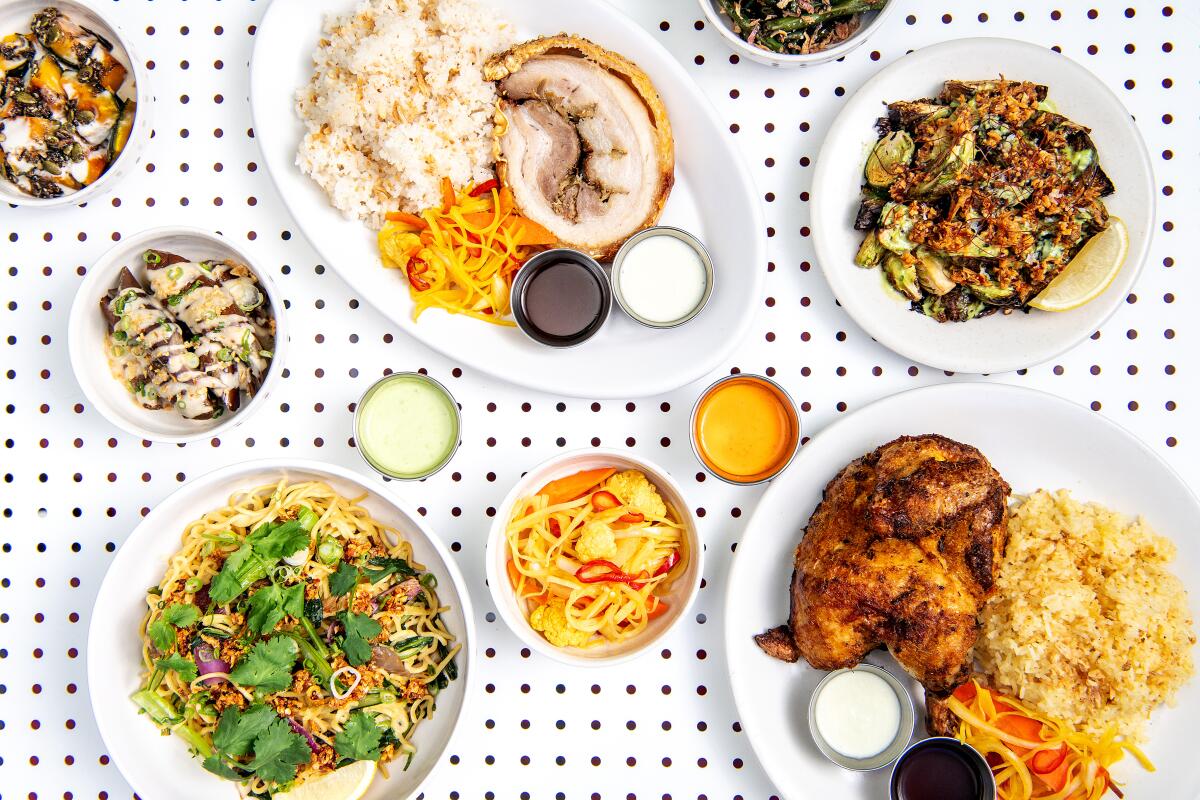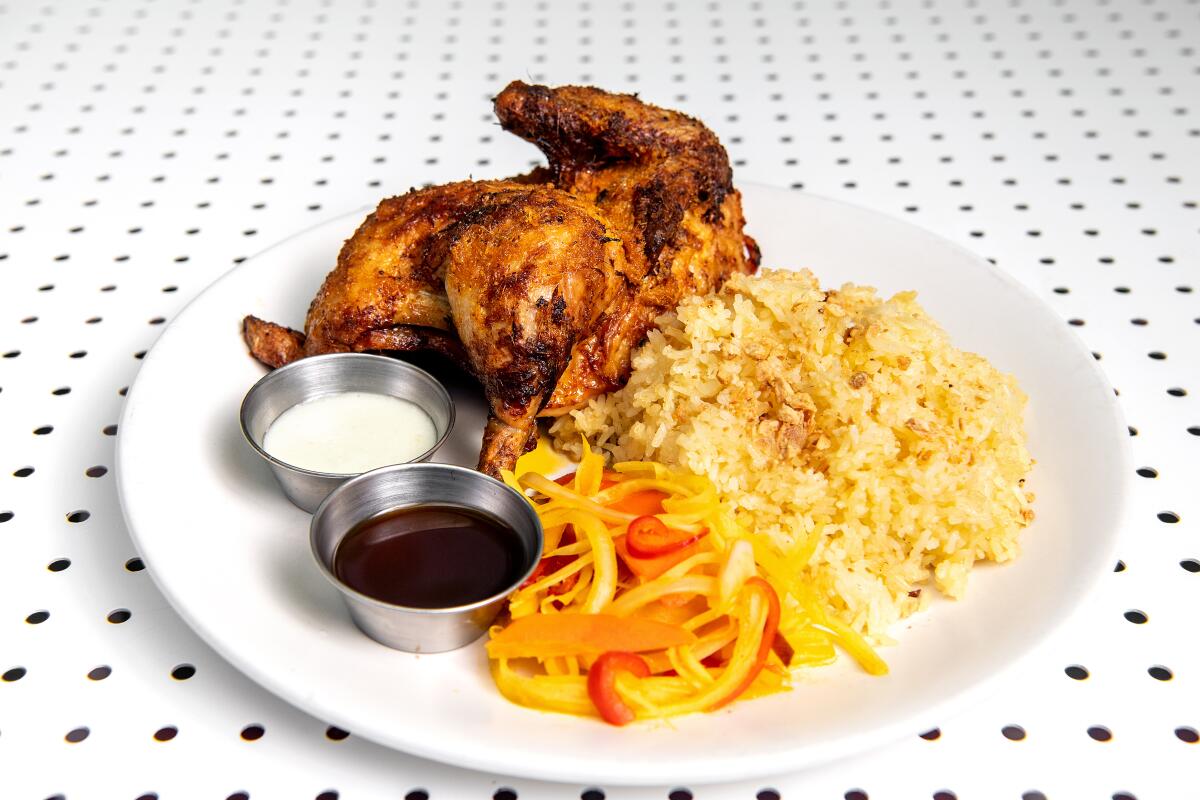This Filipino rotisserie and natural wine bar is made for the times

- Share via
Even before the waves of crisis that engulfed the last two years, even while his restaurant Lasa was settling into pre-pandemic success, Chase Valencia was thinking about Filipino-style rotisserie and how he might serve his favorite versions to Angelenos.
For years, off and on, Valencia had batted around ideas for a rotisserie restaurant with Nico de Leon, the opening chef de cuisine for Lasa. They’d zeroed in on inasal na manok, a chicken specialty of the western Visayan Islands in the central Philippines. The bird soaks up a pungent marinade of lemongrass, ginger, garlic, vinegar, calamansi juice and achiote seeds (which stain everything in their path a shade of burnt orange) before being grilled over flames or cooked on a revolving spit.
Valencia remembered the exceptional Cebuano lechon he tried with his uncle in the same region of the country. Lechon, the method of traditionally slow-roasting whole suckling pig over coals until the skin crackles and the meat nearly melts, is a celebration staple in the Philippines as well as in Puerto Rico, Cuba and the Dominican Republic — a culinary vestige of centuries of Spanish colonialism absorbed by the local cultures. Valencia loved a variation in Cebu City made using pork belly that had been rolled like porchetta and filled with herbs and spices similar to the inasal marinade. Back in the United States, he attempted the recipe for a Lasa holiday gathering; the big flavors and lush, contrasting textures clicked.
COVID-19 of course changed everything. Chase and his brother Chad Valencia, Lasa’s co-owner and executive chef, went into survival mode. They’d begun the venture in 2016 as a pop-up in Unit 120, a restaurant incubator space in Chinatown’s Far East Plaza spearheaded by Alvin Cailan of Eggslut. A year later, Lasa settled into the address long-term. Chad’s cooking became the city’s lodestar for modern Filipino cuisine. In dishes like wok-roasted sugar snap peas robed in coconut green goddess dressing, clams and chayote in green garlic broth sparked with lemongrass-chile oil, lumpia stuffed with winter vegetables and a witty take on “Filipino spaghetti” (pancit tossed in sweet tomato sauce and blanketed with aged cheddar), he wove tradition, nostalgia, intellectualism and seasonality into an original personal-narrative cuisine.
At the beginning of the pandemic, the Valencias and their staff sold meal kits and cooked for emergency workers. They installed a window out of which to sell natural wine, with the bottles lined up on display behind glass. They served customers at generously spaced tables in the courtyard outside the restaurant.

Then in early 2021, after a year of exhausting starts and stops and turning points, Lasa cocooned for a month and reemerged as Lasita, the rotisserie project Chase has been designing with de Leon, who had left for the Bay Area in 2019 and recently returned to Los Angeles. Chad moved on from the business; Chase’s wife, Steff Barros Valencia, became a partner.
The loss of Lasa’s singular expression of Filipino cooking still reverberates, and at once the casual, communal, still-evolving aura of Lasita feels exactly right to the moment.
Inasal and lechon headline the concise menu. The chicken’s copper-colored skin crackles. Toyomansi (soy sauce and calamansi juice) and whipped garlic dip amplify the herbal, citrusy flavors that the marinade infuses into the meat. The pork belly arrives in a thick slice, with flecks of lemongrass visible in the center of the rolled spiral. Its golden rind shatters with pleasure against the teeth.
A plate of inasal comes with glossy chicken fat rice, and the lechon is paired with potent garlic rice; order both meats and then gradually merge their rice sides into a perfect union. Extra sauces — green mango ketchup, scallion-cilantro salsa verde, the reappearance of coconut green goddess, a prickly hot sauce made from fermented bird’s eye and Fresno chiles — add dimension and intrigue.

A handful of other dishes come and go in a slow rotation. For a vegan pancit, thin soba noodles cradle lacy spinach and slivers of oyster mushrooms flavored with garlic, calamansi and flecks of chile crunch. Lechon performs double duty in sisig, the sizzling dish usually comprised of many disparate cuts of minced pork. Stirring in the optional egg, barely set on top, gives the hashed meat a creamy sheen. It’s excellent.
There’s a meatless version of sisig made with mushrooms; combine it with a warming coconut-kabocha curry and long beans in a gentle tamarind-tamari glaze for a satisfying vegan feast.
Prawns grilled with inasal butter and lemon is a work in progress; the ones I had leaned toward mealy, and the flavors didn’t pop with the same force that defines the rest of the food. A variation made with whole pompano as a special a couple of months ago came together in more of a triumph.
As the menu grows incrementally, the wine list has expanded exponentially. Chase found a receptive audience when he set up the window to sell wine in 2020’s darkest months, and his selection of a dozen or so bottles has grown to a list of 70 largely affordable options that run to the lean, bright, minerally and sometimes lightly fizzy qualities that tend to characterize natural wines. He looks for wines that he thinks of as “cutters” — high-acid whites and meant-to-be-served-chilled reds that slice through the salty, garlicky density of the rotisserie meats.
“Natural wine” as a broad, amorphous genre remains an arcane subject to most of us. Chase’s guiding presence is crucial. You order at the counter and the staff brings out plates as they’re ready. You might be flipping through the loose, green sheets of the wine list and Chase, hovering nearby, will divert you to two refrigerators full of wine to have a conversation about what kinds of flavors you gravitate toward and point out some of his favorites.
His enthusiasm and charisma are shaping Lasita into as much a wine bar as a restaurant, cementing the project with its own distinct identity. The reception to the changes is reinforcing the shift. There is indoor and outdoor dining, but most of the action happens alfresco. On most nights Lasita’s courtyard tables are filled with couples and groups of six or eight, half-empty bottles of Chenin blanc or Carignan among nearly polished-off plates, with would-be diners milling on the periphery as they wait for the next available seats. The scene has the energy of fresh beginnings and the makings of a new community hub.
Lasita
727 N. Broadway, Unit 120, Los Angeles, (213) 443-6163, lasita-la.com
Prices: Snacks $6, plates $14-$21, desserts $6.75-$8.50
Details: Dinner Tues.-Sat. 5-10 p.m. Wine and beer. Credit cards accepted. Street parking. Takeout available.
Recommended dishes: Inasal, lechon, sisig, coconut-squash curry, Laroolou’s calamansi cream pie (available on weekends)
More to Read
Eat your way across L.A.
Get our weekly Tasting Notes newsletter for reviews, news and more.
You may occasionally receive promotional content from the Los Angeles Times.










